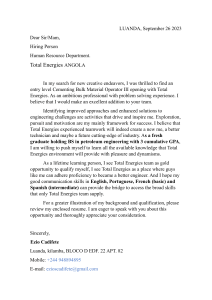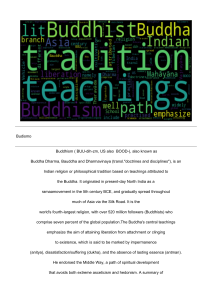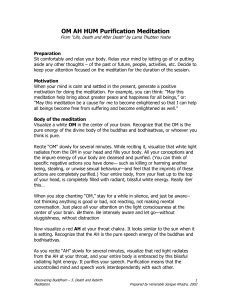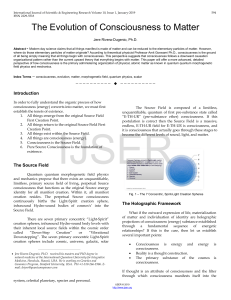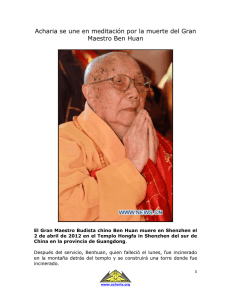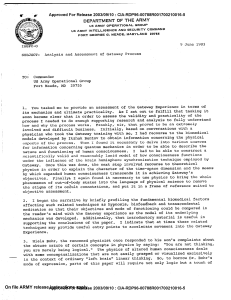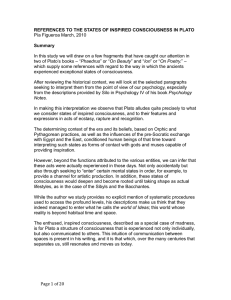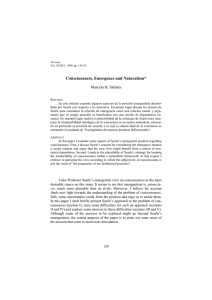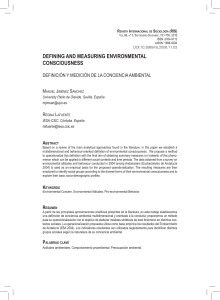SCIENTIFIC AND BUDDHIST VIEWS OF ENERGY
Anuncio
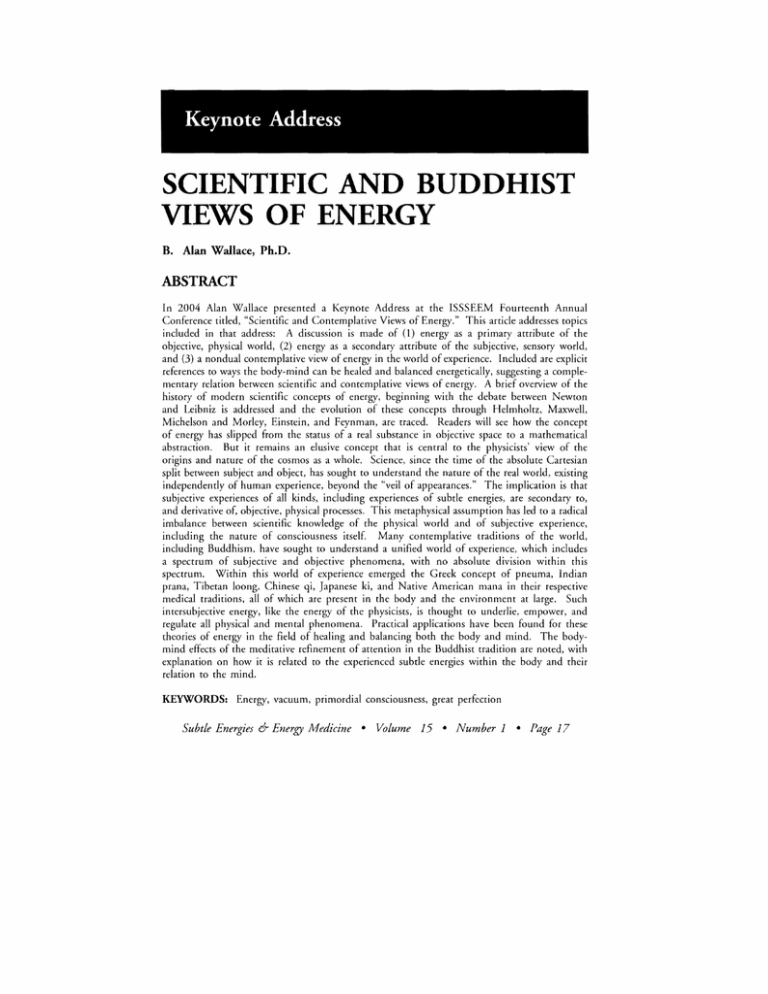
Keynote Address SCIENTIFIC AND BUDDHIST VIEWS OF ENERGY B. Alan Wallace, Ph.D. ABSTRACT In 2004 Alan Wallace presented a Keynote Address at the ISSSEEM Fourteenth Annual Conference titled, "Scientific and Contemplative Views of Energy." This article addresses topics included in that address: A discussion is made of (1) energy as a primary attribute of the objective, physical world, (2) energy as a secondary attribute of the subjective, sensory world, and (3) a nondual contemplative view of energy in the world of experience. Included are explicit references to ways the body-mind can be healed and balanced energetically, suggesting a comple­ mentary relation berween scientific and contemplative views of energy. A brief overview of the history of modern scientific concepts of energy, beginning with the debate berween Newton and Leibniz is addressed and the evolution of these concepts through Helmholtz, Maxwell, Michelson and Morley, Einstein, and Feynman, are traced. Readers will see how the concept of energy has slipped from the status of a real substance in objective space to a mathematical abstraction. But it remains an elusive concept that is central to the physicists' view of the origins and nature of the cosmos as a whole. Science, since the time of the absolute Cartesian split berween subject and object, has sought to understand the nature of the real world, existing independently of human experience, beyond the "veil of appearances. The implication is that subjective experiences of all kinds, including experiences of subtle energies, are secondary to, and derivative of, objective, physical processes. This metaphysical assumption has led to a radical imbalance berween scientific knowledge of the physical world and of subjective experience, including the nature of consciousness itself. Many contemplative traditions of the world, including Buddhism, have sought to understand a unified world of experience, which includes a spectrum of subjective and objective phenomena, with no absolute division within this spectrum. Within this world of experience emerged the Greek concept of pneuma, Indian prana, Tibetan loong, Chinese qi, Japanese ki, and Native American mana in their respective medical traditions, all of which are present in the body and the environment at large. Such intersubjective energy, like the energy of the physicists, is thought ro underlie, empower, and regulate all physical and mental phenomena. Practical applications have been found for these theories of energy in the field of healing and balancing both the body and mind. The body­ mind effects of the meditative refinement of attention in the Buddhist tradition are noted, with explanation on how it is related to the experienced subtle energies within the body and their relation to the mind. KEYWORDS: Energy, vacuum, primordial consciousness, great perfection Subtle Energies 6- Energy Medicine • Volume 15 • Number 1 • Page 17 A SHORT HISTORY OF ENERGY IN PHYSICS T raditional theories of vital energies developed in the classical civiliza­ tions of China, India, and Greece are commonly viewed in contempo­ rary scientific and philosophical circles as antiquated expressions of folklore physiology. All such notions appear to be variations of the school of "Vitalism," which held that living organisms are endowed with a kind of energy unique to life. No such energy has been found by the physical or biological SCIences. The downfall of Vitalism can be traced back to the establishment of the principle of the conservation of energy, for which Hermann von Helmholtz presented the first mathematical formulation in 1847. In a paper presented in that year, he treated mechanical phenomena, heat, light, electricity, and magnetism as different manifestations of energy, which he correctly foresaw would serve as a unifYing principle in physics. The actual term "energy" was first used as a general and fundamental concept by William Thompson two years later. In his view, energy is an objectively real, quantitatively immutable entity that is convertible and links all of nature in a web of energy transfor­ mations. Helmholtz saw his formulation of energy conservation as key to "the complete comprehensibility of nature,"l which could be understood thoroughly in terms of mechanisms. For light, electricity, and magnetism such a mechanical explanation required the existence of a luminiferous ether. But in 1887, the assertion of this mechanical medium for electromagnetic energy was disproved by the renowned Michelson-Morley experiment. Looking back, Albert Einstein and his colleague Leopold Infeld declared, "All assumptions concerning ether led nowhere!"2 And this was a critical blow to the mechanistic view of nature as a whole. In 1905, Einstein revolutionized the scientific understanding of energy with his special theory of relativity. With his famous equation E = mc 2, he demonstrated that matter is convertible with energy and in fact is nothing other than a form of energy. With the subsequent development of quantum electrodynamics, energy and matter came to be viewed as oscillations of abstract field quantities in space. A far cry from the mechanical explanation idealized in the mid-19 th Subtle Energies & Energy Medicine • Volume 15 • Number 1 • Page 18 century, particles and waves are not even oscillations of space proper, for nothing actually oscillates. In the words of physicist Henning Genz, "Real systems are, in this sense, 'excitations of the vacuum'-much as surface waves in a pond are excitations of the pond's water. . .. The vacuum in itself is shapeless, but it may assume specific shapes. In doing so, it becomes a physical reality, a 'real world."'3 This vacuum contains an infinite supply of radiation energy even at zero temperature. The mechanical view of nature, in which the principle of energy conservation played a crucial role, has now been overthrown by physics itself. Richard Feynman concluded that the conservation of energy is a mathematical principle, not a description of a mechanism, or anything concrete. Moreover, "It is important to realize that in physics today," he acknowledged, "we have no knowledge of what energy is."4 T o relate this conclusion back to the origins of Western science and philosophy, Pythagoras was renowned for his claim that all things are numbers, and later Pythagoreans identified these numbers with geomet­ rical forms. Inspired by the Pythagoreans, Plato developed his own theory that the world of appearances is derivative of an underlying realm of pure ideas. Democritus, on the other hand, claimed that the world ultimately consists of discrete atoms in motion in space and that all subjective experiences are deriva­ tive of configurations of atoms. In terms of the quantum mechanical understanding of the nature of energy, Werner Heisenberg commented, "With regard to this question, modern physics takes a definite stand against the materi­ alism of Democritus and for Plato and the Pythagoreans. '6 Descartes has left science with a legacy of dividing the world into an absolutely objective realm of physical phenomena and an absolutely subjective realm of mental phenomena. In this context, classical physics came to regard energy as a primary attribute of the objective, physical world, and all subjective, mental phenomena were seen as secondary, derivative qualities of configurations of atoms. But in light of the above discussion of advances in modern physics, I would characterize the real physical world as nothing more than dynamical configurations of some kind of quantized background, about which there are a variety of mathematical ideas. These mathematical ideas serve to pick out possible regularities that may be of some predictive and explanatory value. Subtle Energies & Energy Medicine • Volume 15 • Number 1 • Page 19 Some believe these ideas are subjective creations of the human psyche, while others maintain they are objective entities existing independently of conscious­ ness. But a third alternative, as Plato proposed, is that they may belong to a dimension of consciousness that transcends the ordinary human mind and that plays a key role in the formation of the universe as a whole. BUDDHIST VIEWS OF SUBTLE ENERGY AND PURE FORMS U nder the influence of the mechanistic views of Democritus and Descartes, physics has probed the nature of space and energy in a world devoid of consciousness and subjective experience of any kind. But the real world-the only one we know exists-is the universe of which we are conscious. Many traditional cultures have viewed this world of experience as being filled with energy, conceived in various ways. The Greek pneuma, Indian prana, Tibetan loong, Chinese qi, Japanese ki, and Native American mana are all believed to be present in the human body and the surrounding environ­ ment. Mana, like the energy of the physicists, is thought to underlie, empower, and regulate all physical and mental phenomena. In Buddhism, the energies coursing through the human body are investigated from a first-person perspective by first honing the attention by means of sophis­ ticated contemplative training. Many techniques have been devised to regulate these energies with the practice of physical exercises, controlled breathing, visualization, and mantra recitation. But another approach entails a passive mindfulness of the respiration, without trying to regulate or modify it in any way. Through such practice, the energies in the body naturally balance themselves, and in so doing, the mind is also calmed. This is a practice highly praised by the Buddha, who described its effects with these words: 6 Just as in the last month of the hot season, when a mass of dust and dirt has swirled up, a great rain cloud out of season disperses it and quells it on the spot, so too concentration by mindfulness of breathing, when developed and cultivated, is peaceful and sublime, an ambrosial dwelling, and it disperses and quells on the spot detrimental unwhole­ some states whenever they arise. Subtle Energies & Energy Medicine • Volume 15 • Number 1 • Page 20 The practice of mindfulness of breathing is one of many Buddhist techniques for developing the stability and vividness of attention, culminating in the highly refined state of meditative quiescence (Samatha), in which the mind can remain perfectly focused for hours on end. The development of quiescence is closely linked to three kinds of "signs" (nimitta) that are the objects of meditation. The first of these is the sign for preliminary practice, which in the case of the mindfulness of breathing consists of the tactile sensations of the respiration. The second is the acquired sign (udgraha-nimitta) , which may appear to different people like a star, a cluster of gems or pearls, a wreath of flowers, a puff of smoke, a cobweb, a cloud, a lotus flower, a wheel, or a moon or sun disk. All these signs of the breath arise from the space of the mind, and their various appearances are related to the mental dispositions of individual medita­ tors. The third is the counterpart sign (pratibhaga-nimitta), which is a subtle, emblematic representation of the whole quality of the breath, or air element, which it symbolizes. T he experience of the counterpart sign corresponds to the achievement of meditative quiescence, which entails a dramatic shift in the energies in the body. This is initially characterized by a sense of heaviness and numbness on the top of the head, which is correlated to the emergence of an exceptional degree of mental pliancy and fitness. Vital energies that result in unprecedented physical pliancy then pervasively course through the entire body, filling it with the power of this dynamic energy. A sense of bliss then saturates the body, which, in turn, triggers an experience of mental bliss. This gradually subsides, leaving both the body and mind balanced and supple. The achievement of quiescence marks the contemplative's initial access to a higher realm, or dimension, of existence. Prior to this achievement, one's mind was confined to what is known as the desire realm (kamadhatu) , which is so called because it is dominated by sensual desire. With the experience of the counterpart sign, the mind ascends to a realm of pure forms (rupadhatu), which is a more rarefied dimension of existence beyond the human physical senses. 8 Upon gaining access to this realm, one's consciousness is stripped of its uniquely human characteristics, including one's ethnicity, gender, language, and other modes of biological and cultural conditioning. 9 From this dimension of conscious experience, one transcends the limitations of human sensory percep­ tion and human concepts. Subtle Energies & Energy Medicine • Volume 15 • Number 1 • Page 21 Buddhist contemplatives discuss a variety of pure forms, or ideas, that are perceived once one gains access to the form realm. These include rarefied, archetypal representations of phenomena experienced in the desire realm, including the elements of earth (solidity), water (fluidity), fire (heat), air (motility), light, and space. In addition, they claim that physical reality may be altered by the contemplative manipulation of these signs. 1o While such abilities are commonly viewed in the West as miraculous, in Buddhism they are considered to be natural abilities of consciousness that has been elevated to the dimension of the form realm. The Indian Buddhist contemplatives Nagarjuna and Asanga clearly state in their treatises Precious Garland and Compendium of Higher Knowledge that the elements perceived by our physical senses are derivative of a more subtle dimension of existence. T he form realm accessed by achieving meditative quiescence bears remarkable similarities to the realm of number, geometric forms, and ideas proposed by the Pythagoreans and Plato. These are not purely objective, in the sense of existing independently of consciousness, but nor are they purely subjective in the sense of being of the human mind. Rather, they exist in a subtle dimension of experience that can be perceptually accessed by means of contemplative practice, and conceptually accessed by means of mathematical analysis. Theoretical physics provides us with conceptual, quanti­ tative insight into the nature of space devoid of consciousness, whereas Buddhism presents experiential insights into the nature of subtle dimensions of space suffused with consciousness. BUDDHIST VIEWS OF PRIMORDIAL CONSCIOUSNESS, SPACE, AND ENERGY When meditative quiescence is achieved, the human psyche, conditioned by biological and social influences, dissolves into a more fundamental dimension of consciousness known as the substrate consciousness (alayavijiiana). This is characterized by the three qualities of bliss, luminosity, and freedom from human conceptuality. When resting in that state, what objectively appears to this consciousness is a space-like vacuity and blankness, devoid of sensory and mental appearances. This is also accessed in deep, dreamless sleep, when Subtle Energies & Energy Medicine • Volume 15 • Number 1 • Page 22 fainting, and in the dying process, but in those situations there is usually not enough mental clarity to recognize this mental void for what it is. Buddhist contemplatives have probed beyond this relative vacuum state of the mind, penetrating to the deepest dimension of awareness, known as primor­ dial consciousness (jfzi:ma). This is the non-local, atemporal, ultimate ground state of awareness, and it is nondual from the absolute space of phenomena (dharmadhiitu) , out of which the whole world of spaceltime and mind/matter emerges. This luminous space of primordial consciousness is also imbued with infinite energy, out of which all other forms of thermal, kinetic, electromag­ netic, and gravitation energy emerge. As such, this dimension of reality transcends all conceptual dualities of matter and energy, space and time, subject and object, mind and matter, and even existence and non -existence. I n the Buddhist view known as the Great Perfection (Dzogchen), all mental and physical phenomena are viewed as manifestations of this primordial unity of infinite consciousness, space, and energy. Dlidjom Lingpa, a renowned 19 th -century Tibetan Buddhist contemplative, describes the absolute space of phenomena in this way: II Due to the radiant, clear aspect of space, it can appear as earth, fire, water, air, form, sound, smell, taste, and as tactile objects. That is like the appear­ ance of various reflections, the planets, and stars due to the limpid and clear aspect of the ocean. All those reflections, planets, and stars are none other than the ocean itself, and they are of the same nature. . .. Due to the unceasing power in the nature of primordial consciousness, there is total knowledge and total awareness of all phenomena, without its ever merging with or entering into objects. Primordial consciousness is self-originating, naturally clear, free of outer and inner obscuration; it is the all-pervasive, radiant, clear infinity of space, free of contamination. THE COMPLEMENTARITY OF SCIENCE AND BUDDHISM According to many contemporary physicists, the energy of empty space played a key role in the formation of the universe following the Big Bang. Science writer K. C. Cole comments in this regard: I2 Subtle Energies 6- Energy Medicine • Volume 15 • Number 1 • Page 23 Like water freezing into ice and releasing its energy into its surroundings, the "freezing" of the vacuum liberates enormous amounts of energy. . .. As simply as water freezing into ice, the inflated vacuum froze into the structure that gave rise to quarks, electrons, and eventually us. This view provides deep insight into the nature of the physical universe, but it is one in which consciousness plays no role whatsoever. In contrast, according to the Great Perfection view of Buddhism, empty space, permeated by the light of consciousness is the ground of all existence. Dildjom Lingpa describes this ground as follows: 13 This ground is . . . like water in its natural, fluid state freezing in a cold wind. It is due to dualistic grasping onto subjects and objects that the ground, which is naturally free, becomes frozen into the appearances of things. Neither the scientific nor the Buddhist view of energy is complete. The scientific view of the universe has little to say about the origins, nature, or role of consciousness in nature. And the Buddhist view has no objective, quanti­ tative means of examining energy. Rather than viewing the modes of inquiry of these two great traditions as incompatible, it may be more fruitful to regard them as complementary. Like focusing two eyes on the same reality, with the integration of these two perspectives, we may discover a deeper and more encompassing vision than either tradition has achieved on its own. • • • CORRESPONDENCE: B. Alan Wallace, Ph.D. • Santa Barbara Institute • 2716 Exeter Place, Santa Barbara, CA 93105 • alanwallace@earthlink.net REFERENCES & NOTES 1. 2. 3. 4. 5. 6. P. M. Harman, Energy, Force and Matter: The Conceptual Development of Nineteenth Century Physics (Cambridge University Press, Cambridge, MA, 1982), p. 43. Albert Einstein & Leopold Infeld, The Evolution ofPhysics (A Touchstone Book, Simon & Schuster, New York, NY, 1966 [originally published in 1938]), p. 175. Henning Genz, Nothingness: The Science of Empty Space [trans. Karin Heusch] (Perseus Books, Cambridge, MA, 1999), p. 26. Richard Feynman, R. B. Leighton & M. Sands, The Feynman Lectures on Physics (Addison­ Wesley, Reading, MA, 1963), pp. 4-2. Werner Heisenberg, Physics and Philosophy (Penguin Books, London, 1989), p. 59. Samyutta Nikiiya V, 321-2, The Connected Discourses of the Buddha, Vol. II. Bhikkhu Subtle Energies & Energy Medicine • Volume 15 • Number 1 • Page 24 7. 8. 9. 10. 11. 12. 13. Bodhi, Trans. (Wisdom Publications, Boston, MA, 2000), p. 1774. [I have altered the translation slightly. Paravahera Vajirafiana, Buddhist Meditation in Theory and Practice (Kuala Lumpur, Malaysia: Buddhist Missionary Society, 1975), p. 145. Tsongkhapa discusses these, and even more abstract, states of samadhi in his Treatise on Meditative Stabilization and the Formless [bSam gtan gzugs med kyi bstan bcos (Collected Works, Vol. Tsha)]. Cf. Leah Zahler, Meditative States in Tibetan Buddhism (Wisdom, London, 1983). Anne C. Klein, "Mental Concentration and the Unconditioned: A Buddhist Case for Unmediated Experience, In Paths to Liberation: The Marga and Its Transformations in Buddhist Thought (Robert E. Buswell, Jr. & Robert M. Gimello, Eds., University of Hawaii Press, Honolulu, HI, 1992). [Studies in East Asian Buddhism 7]. Buddhaghosa's The Path of Purification [trans. by Bhikkhu Nanamoli] (Buddhist Publication Society, Kandy, 1979), Part II. Dlidjom Lingpa (bDud 'joms gling pa), The Vajra Essence, Dag snang ye shes drva pa las gnas lugs rang byung gi rgyud rdo rje'i snying po. Sanskrit title: Vajrahrcktyasuddhad­ hutijfzanaharefrilamjatiyatisma. Collected Works of H. H. Dudjom Rinpoche (Kunsang, T opgay,Thimphu, Bhutan, 1978), pp. 108 & 362. K. C. Cole, The Hole in the Universe: How Scientists Peered over the ofEmptiness and Found Everything (Harcourt, New York, NY, 2001), pp. 177-178. Dlidjom Lingpa, The Vajra Essence, p. 368. 00 00 00 Subtle Energies & Energy Medicine • VoLume 15 • Number 1 • Page 25
